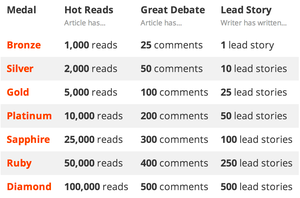We've heard of gamifying the reader experience, but what about gamifying the writer experience? Bleacher Report has built a sports media empire with analytics, and a touch of gamification, at its core.
There's a peculiar dichotomy in the media at the moment: while digital editors debate the merits of metrics, and whether writers should be shown analytics about their own pieces, many of those same news organisations show readers metrics on their own activity as part of a gamification system, to encourage and reward them for doing actions the publications value.
What I mean is this: a few intrepid news sites have turned to gamification to guide reader behavior, but how many media outlets have considered gamification to guide writer behavior?

While leading an on-stage interview with David Nemetz, cofounder of Bleacher Report, at the Digital Media Europe conference in London, I asked him about how they used metrics to inform their editorial strategy. Unsurprisingly, data analytics played a central role in the sport site's meteoric rise to the 2nd most popular destination for sports news in America, with over 70 million unique monthly visitors.
"The analytics team works as our experimentation engine." - David Nemetz, Bleacher Report
One of the more interesting topics we touched on was the use of game design and rankings for their journalists.
Measurement Matters
If, as Raju Narisetti put it at the Tablet and App Summit in Berlin last fall, "the definition of a journalist must include, 'I will bring new readers to my journalism'", then surely journalists should be given some kind of indication of their performance in this task?
"In 2013, the definition of a journalist must include, 'I will bring new readers to my journalism'". - Raju Narisetti, SVP of Strategy, News Corp
And yet many editors, from both traditional and younger media operations alike, worry that showing writers metrics might damage the quality of their journalism, driving them to chase pageviews instead of some more worthy, and perhaps immeasurable, objective like impact.
Nilay Patel, Manager Editor at The Verge - a technology news site founded in 2011, doesn't allow his writers access to the site's Google Analytics account. He explained in a recent AJR article, "Our core strength is that we do the news and it's out there, but you want to come to us because we're smarter and more authoritative and better, and I don't think you can measure that in terms of pageviews."
In the same article, Chris Moran, Digital Audience Editor at The Guardian, expressed his opposing point of view, "Are we honestly so scared of numbers that we believe it will lead us to abandon our journalistic principles?"
I asked Aron Pilhofer, then Assistant Managing Editor for Digital Strategy at The New York Times (Pilhofer is now Executive Editor of Digital at The Guardian), what he thought about showing journalists analytics about their stories. He replied via email, echoing Moran's sentiment:
"I don't think we need to keep treating journalists like children in this way. They want to know, and should know."
A Guide to Greatness
In its early days, Bleacher Report (or B/R for short) came under almost continuous fire, arousing vitriol from practiced sports reporters and passionate sports fans alike. The quality of coverage was questioned, as were the extensive use of slideshows with almost scientifically crafted "clickbait" headlines. In fact, the media's attitude towards B/R was much like its attitude towards the early BuzzFeed, dismissive and patronizing.
The fact that B/R relied so heavily on contributed articles from amateur writers and die-hard sports fans - there were about 6000 contributors at the time it was sold to Time Warner for around $200M in 2012 - meant it had a pronounced need to sort these writers in some way, and to guide the amateurs towards producing the kinds of pieces that were of highest value to the operation.
Enter the Bleacher Report Writer Ranking system, an extract from the website explains:
"In sum, B/R's Writer Rankings incentivize behavior consistent with the principles of genuinely "great" sports journalism: Authors are encouraged (1) to do their best work every time they publish and (2) to sustain that effort over the long run. It's by no means an easily-achieved ideal--but then again greatness wouldn't be greatness if it were easy to do."

The Writer Ranking system recognizes journalists' performance in three categories for every article they produce:
- pageviews
- comments generated
- if it is featured by an editor on homepage
Each of these metrics have different "gem levels", for example a story that generates 25 reader comments will earn the writer a bronze version of the "great debate" badge, 500 comments will get them the diamond badge.
The Writer Ranking program doesn't just stop with badges, it also relates all these individual achievements into an overall "reputation level", based on total points earned. Reputation levels begin at Contributor I and span to Chief Writer III, high achievers can be selected by editors and granted Featured Columnist status, a separate elite hierarchy with rankings from I to IV.
The advantage of using a ranking system like this, as opposed to just giving writers access to the analytics dashboard, is that it highlights the most important metrics for the news organization, and allows writers and editors to easily understand, and compare, an author's performance in those key areas. After all, metrics without a point of reference become irrelevant.
A Tool for Recruitment
B/R has intelligently built this system right into its recruitment tactics, encouraging hopefuls applying to its Sports Media Program - a next-level internship program - to build their portfolio by joining the Writer Ranking program before applying. The page for the Sports Media Program explains:
"Once upon a time, aspiring journalists could take entry-level jobs with newspapers or magazines and work their way up. Today, by contrast, every rookie has to build his or her own foundation on a fiercely competitive playing field. And that's where Bleacher Report can help."
A Framework for Adaptation
While B/R has chosen these three metrics to gamify, obviously different news organizations may wish to emphasize different metrics. For example, Gawker Media recently began awarding end-of-month bonuses to writers "based in part on the number of new unique visitors they've lured to the site that month."
This structure employed by B/R could be easily adapted to award authors according to:
- new unique users attracted to the site by an article (or every month)
- viral lift on an article (or average viral lift per month)
Taking it a step further, this framework could even be used to assess the value of each writer's own cohort of readers, and encourage writers to find a voice and style that attracts loyal, highly valuable readers.
The audience value rankings could be made based on:
- average pageviews per visit for users entering the site from their articles
- average time spent per visit for users entering the site from their articles
- new registrations or newsletter sign ups driven from their articles
Not only would this keep editors better informed about the value of their talent, it would also empower journalists by giving them a clear indication of their value to the operation.
This is Not a Game
I think the term gamification gets a bad wrap, and I honestly believe that what we're looking at here is not turning journalism into a game. Instead, it's a framework to assess the performance of news operations down to the writer and article level, according to the metrics that are important to the organisation. Even qualitative measures, like whether a story deserves to be featured on the homepage, can be accounted for with this approach.
At the very least, Bleacher Report's example provides food for thought for those digital editors considering how to make the most of the plethora of site analytics they now have access to. But is Bleacher Report's approach only applicable to sports journalism? Pilhofer, then at the NYTimes, weighed in via email, "Not at all. I think it's applicable to all journalism."
* This article was originally published on The Media Briefing